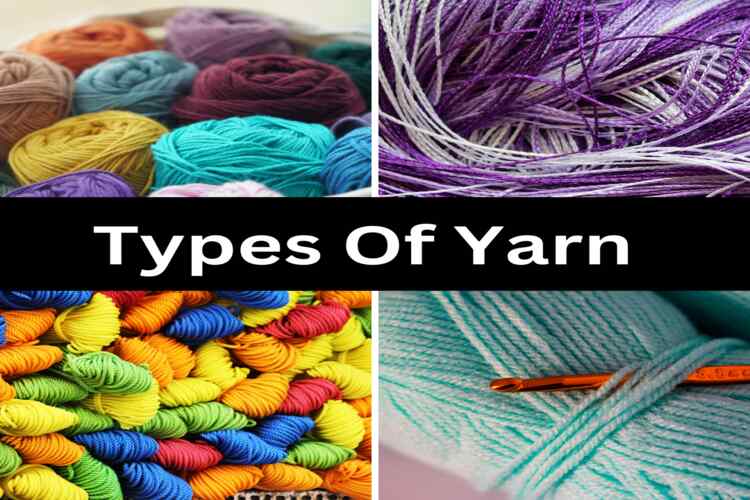What is yarn?
Yarn is made by putting fibers together, either by laying them side by side or twisting them into a long strand. Yarns can be created from staple fibers, which need twisting, or filament fibers, which usually don’t need much twist to stay together in the yarn.
Yarn-type base on Filament
Filament yarn is made up of fibers that don’t have loose ends. This enduring and unbroken fiber is called a filament. Filament thread is commonly, though not always, spun before it’s put to use. The level of twist in filament yarn is typically quantified as TPM or TPI.
- Monofilament yarn: Monofilament yarn is a single unbroken fiber, typically synthetic like nylon or polyester, with no twists or plies. It’s used for creating items like fishing lines, sturdy sewing threads, sports gear, medical sutures, mosquito nets, and screen mesh.
- Multi-filament yarn: Multi-filament yarn is created by combining numerous thin threads, often made from materials like nylon, polyester, or rayon. It’s distinct from single-thread yarn, offering increased strength and texture. This yarn is commonly employed in sewing, knitting, and apparel production, thanks to its versatility in adjusting the number and arrangement of threads to suit various applications.
On the basis of the number of plies, the yarn can be classified into two categories
- Single-ply yarn
- Multi-ply yarn
- Single-ply yarn: Ply yarns are individual yarn threads that intertwine with each other. When we refer to single-ply yarn, we’re talking about yarn made from a single thread, with its fibers held together by a delicate twist. Incorporating a single strand of yarn gives knitted and crocheted items a unique appearance. You may observe a softer overall texture with a less pronounced stitch definition. Typically, most single-ply yarns have a gentle fluffiness surrounding them.
- Multiply’s yarn :The production of yarn entails the process of spinning together two or more threads. Multi-ply yarn excels in strength compared to single-ply yarn because it incorporates extra twists within each layer and introduces an additional twist to securely bind all the layers together.
On the basis of the direction of the twist the spun yarn can be classified into three categories
- S – twist yarn
- Z – twist yarn
- Zero twist or twist less yarn
- S – twist yarn: In an S twist yarn, if you examine it closely, you’ll notice that the individual fibers or strands spiral upwards from left to right, creating an “S” shape. This twist direction can influence the yarn’s properties, such as its strength, texture, and how it behaves when used in knitting, crocheting, or weaving projects.
- Z – twist yarn: When you take a close look at Z twist yarn, you’ll notice that its individual fibers or strands spiral upward from right to left, forming a shape similar to the letter “Z.” This specific twist direction can influence the yarn’s characteristics, including aspects such as its strength, texture, and how it behaves when used in knitting, crocheting, or weaving projects.
- Zero-twist or twist less yarn: This yarn is crafted by wrapping a dissolve-in-hot-water filament with straight staple fibers. The wrapping process utilizes hot water-soluble filaments. When the fabric is woven, these filaments dissolve in hot water. This makes the fabric, woven with spun yarn, appear without twists, leading to its name “zero twist yarn.”
Cord yarns
Cord yarns also referred to as corded yarns or corded threads, are crafted by twisting multiple plies or individual yarn strands together, resulting in a thicker and more resilient cord-like structure. These plies or strands are twisted in a specific arrangement to create the appearance of ropes, and this spinning process can vary in terms of tightness and direction (clockwise twist or counterclockwise twist), resulting in diverse textures and characteristics in the rope-like thread.
These threads are commonly employed in various crafting, sewing, and textile endeavors. They are highly valued for their durability and strength, making them perfect for projects that require robustness and the ability to withstand demanding conditions, such as crafting bag handles, waistbands, cords, and other items subject to heavy usage and wear.
Compact yarn
A special compact spinning device in the ring frame is used to create this type of yarn. Compared to other spun yarns, this yarn stands out with its excellent strength, evenness, luster, and feel. It doesn’t have short fibers or dirt, showing the fewest irregularities and just the right level of hairiness.
Novelty yarns
Novelty yarns are special because they have unique features and structures. They’re also called complex yarns. These yarns have interesting irregularities like curls, loops, twists, and different colors along their length. Their unique look is used to make attractive fabrics. You can find novelty yarns in many colors, textures, and types of fibers, giving you lots of choices for creative projects.
You may also like:
- What is Linen Fiber? Properties, Structure, and How It Made?
- Identification of Textile Fibers
- What is Jute Fiber? Properties, Advantages and Disadvantages.
- What is Hemp Fiber? Properties, Advantages and Disadvantages.
- What is Ramie Fiber? Properties, Advantages and Disadvantages.
- What is Sisal Fiber? Properties, Structure, and How It Made?
- Pina Fiber: History, Properties, Production Process
- Coir Fiber: Properties, Production Process and Advantages
- Rayon Fiber: History, Properties, Advantages and Disadvantages
- Acrylic Fiber: History, Properties, Advantages
- Yarn Manufacturing Process
- Nylon Fiber: Properties, Advantages and Disadvantages
- Count of Yarn: Explanation and Varieties
Share this Article!

